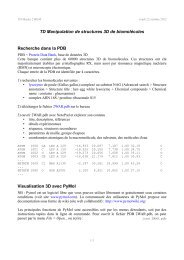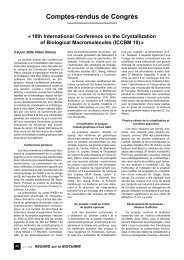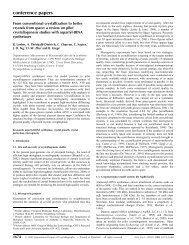Crystal Structure of the Archaeal Asparagine Synthetase ... - Free
Crystal Structure of the Archaeal Asparagine Synthetase ... - Free
Crystal Structure of the Archaeal Asparagine Synthetase ... - Free
You also want an ePaper? Increase the reach of your titles
YUMPU automatically turns print PDFs into web optimized ePapers that Google loves.
448 <strong>Archaeal</strong> <strong>Asparagine</strong> Syn<strong>the</strong>tase <strong>Crystal</strong> <strong>Structure</strong><br />
phosphate group. Finally, this positioning is completed<br />
by <strong>the</strong> side chain <strong>of</strong> Arg99, which contacts<br />
both <strong>the</strong> phosphate group <strong>of</strong> AMP and <strong>the</strong> carboxamide<br />
group <strong>of</strong> Asn.<br />
When comparing <strong>the</strong> AS-AR/AMP and AS-AR/<br />
AMP/Asn structures, we can see that very few<br />
structural rearrangements occur; indeed, no sidechain<br />
movement is observed. However, <strong>the</strong> phosphate<br />
group <strong>of</strong> AMP is shifted in order to prevent<br />
steric hindrance with <strong>the</strong> carboxamide group <strong>of</strong> Asn<br />
(Fig. S5). Fur<strong>the</strong>rmore, except for <strong>the</strong> Arg267 sidechain<br />
movement, no structural rearrangement is<br />
observed in <strong>the</strong> binding site when comparing <strong>the</strong><br />
AS-AR/AMP/Asn and AS-AR/Asn complexes.<br />
Fig. 9. Comparison <strong>of</strong> AMP and Asn binding in<br />
monomers A and B <strong>of</strong> AS-AR. (a) Superposition <strong>of</strong> <strong>the</strong><br />
two monomers from <strong>the</strong> AS-AR/Asn/AMP structure.<br />
Ligands from monomer A are shown in yellow, while<br />
those from monomer B are shown in cyan. (b) Recognition<br />
<strong>of</strong> AMP and Asn in monomer B <strong>of</strong> <strong>the</strong> AS-AR/AMP/Asn<br />
structure.<br />
is in <strong>the</strong> vicinity <strong>of</strong> O1P and O3P atoms. These atoms<br />
establish hydrogen bonds with water molecules<br />
contacted by Glu192, Glu215, and Ser218, and<br />
coordinating Mg 2+ .<br />
Binding <strong>of</strong> <strong>the</strong> Asn and AMP end-products<br />
The two monomers differ strongly in <strong>the</strong> binding<br />
<strong>of</strong> Asn and AMP end products. As for AS-AR bound<br />
to AMP, <strong>the</strong> flipping loop could be rebuilt only in<br />
monomer A, while no electron density is visible for<br />
residues 49–61 in monomer B. In monomer A, AMP<br />
is bound quite similarly as in <strong>the</strong> absence <strong>of</strong> Asn. The<br />
adenine ring and <strong>the</strong> ribose are indeed contacted by<br />
<strong>the</strong> same amino acid groups (Figs. 7 and 8a and b).<br />
The phosphate group interacts with <strong>the</strong> side chains<br />
<strong>of</strong> Arg99 and Glu215. As in <strong>the</strong> AS-AR/AMP<br />
structure, a Mg 2+ is in <strong>the</strong> vicinity <strong>of</strong> <strong>the</strong> AMP<br />
phosphate group. This ion is coordinated by <strong>the</strong><br />
AMP phosphate group, by <strong>the</strong> side chain <strong>of</strong><br />
Glu215, and also by two water molecules that are<br />
maintained by <strong>the</strong> side chains <strong>of</strong> Asp52 and Asp206.<br />
The binding <strong>of</strong> Asn is very similar to that in <strong>the</strong><br />
AS-AR/Asn structure. The recognition <strong>of</strong> <strong>the</strong> Asn<br />
α-carboxylate, NH 2 , and carboxamide groups is<br />
indeed <strong>the</strong> same (Figs. 6a and 8b). The side chains <strong>of</strong><br />
Gln116, Glu192, and Ser75 contribute to <strong>the</strong> positioning<br />
<strong>of</strong> <strong>the</strong> Asn carboxamide group near <strong>the</strong> AMP<br />
Comparison <strong>of</strong> nucleotide recognition in AS-AR,<br />
AspRS, AsnRS, and AsnA<br />
As mentioned before, <strong>the</strong> active sites <strong>of</strong> AS-AR,<br />
AsnRS, AsnA, and AspRS are very similar; however,<br />
some differences in <strong>the</strong> binding mode <strong>of</strong> AMP/ATP<br />
are observed. The Asp52 residue located on <strong>the</strong> AS-<br />
AR flipping loop has no equivalent in AsnA, AsnRS,<br />
and AspRS, since this loop is longer than that in class<br />
IIb aaRSs or in bacterial AsnA. Despite <strong>the</strong> different<br />
functions <strong>of</strong> <strong>the</strong> flipping loops, for <strong>the</strong> binding <strong>of</strong><br />
AMP/ATP, similarities in ligand interactions between<br />
<strong>the</strong> four enzymes are found. The stacking <strong>of</strong><br />
<strong>the</strong> adenine ring is also found in AsnA, AsnRS (Fig. 8c<br />
and d), and AspRS. Arg267 <strong>of</strong> AS-AR is strictly<br />
conserved in <strong>the</strong> four enzymes, while Phe114<br />
conserved in AsnRS is replaced by hydrophobic<br />
residues in AsnA (Val114) and AspRS (Ala227). The<br />
AS-AR residues Ser75 and Arg99, contacting <strong>the</strong><br />
phosphate groups, are also conserved in <strong>the</strong> o<strong>the</strong>r<br />
three enzymes (Ser72-Arg100, Ser188-Arg212, and<br />
Ser190-Arg214, respectively, in AsnA, AsnRS, and<br />
AspRS), while Gln116 is only found in AsnA (Gln116).<br />
Residues contacting <strong>the</strong> adenine ring are also highly<br />
conserved in <strong>the</strong> four enzymes. Glu101 and His110<br />
are strictly conserved, while Ser111 is only present in<br />
AsnA but is replaced by a Leu in archaeal AsnRS/<br />
AspRS (Leu221 and Leu224). Finally, Glu266 is only<br />
conserved in AsnRS/AspRS and replaced by a Ser in<br />
AsnA (Ser298). The nucleotide binding in AS-AR has<br />
homologies with <strong>the</strong> nucleotide binding in AspRS,<br />
AsnRS, and AsnA. However, it possesses also a<br />
unique AMP binding mode due to <strong>the</strong> presence <strong>of</strong> its<br />
extended flipping loop contacting <strong>the</strong> phosphate<br />
group via a hexacoordinated Mg 2+ .<br />
AMP release state<br />
The binding <strong>of</strong> Asn and AMP in <strong>the</strong> two monomers<br />
differs. In monomer B, <strong>the</strong> β-amide group <strong>of</strong><br />
Asn is rotated by 90° compared to monomer A (Fig.<br />
9a) and is contacted by Asp47 and Arg99 side<br />
chains. It also establishes a hydrogen bond with <strong>the</strong><br />
O3 <strong>of</strong> <strong>the</strong> AMP ribose. The o<strong>the</strong>r interactions are





